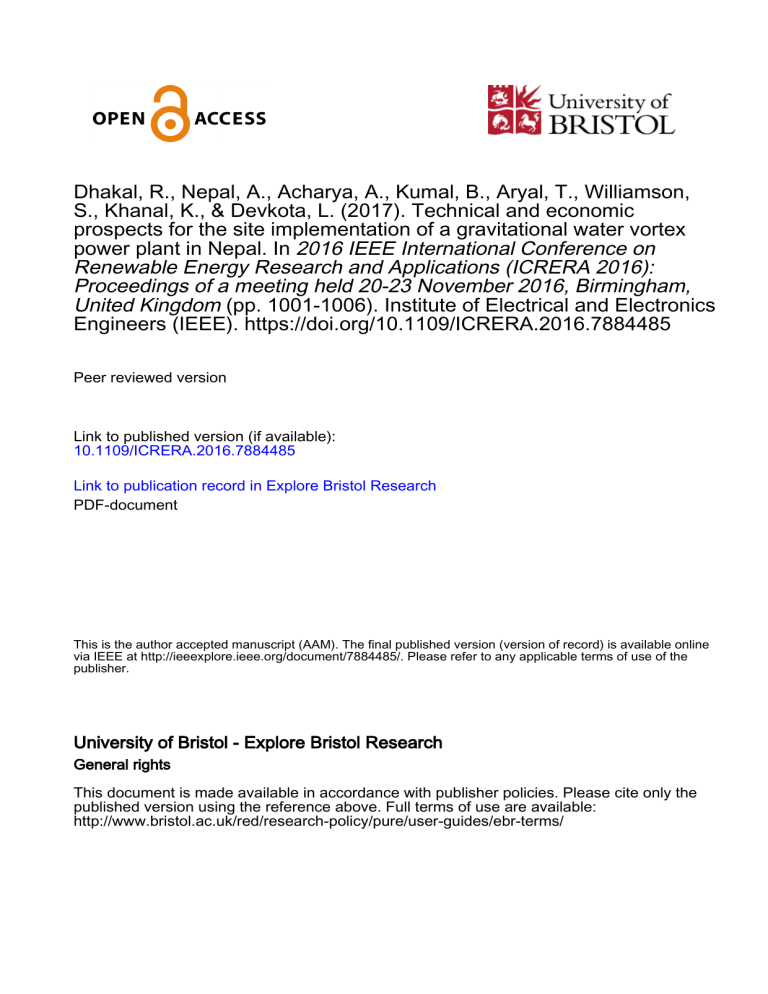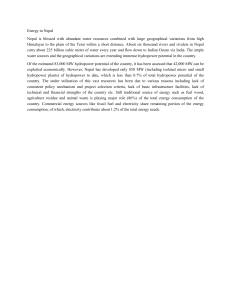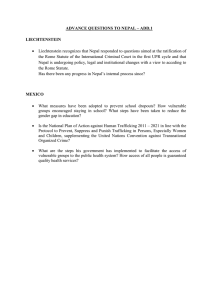Sam Williamson Technical and Economic Prospects for the Site Implementation
advertisement

Dhakal, R., Nepal, A., Acharya, A., Kumal, B., Aryal, T., Williamson, S., Khanal, K., & Devkota, L. (2017). Technical and economic prospects for the site implementation of a gravitational water vortex power plant in Nepal. In 2016 IEEE International Conference on Renewable Energy Research and Applications (ICRERA 2016): Proceedings of a meeting held 20-23 November 2016, Birmingham, United Kingdom (pp. 1001-1006). Institute of Electrical and Electronics Engineers (IEEE). https://doi.org/10.1109/ICRERA.2016.7884485 Peer reviewed version Link to published version (if available): 10.1109/ICRERA.2016.7884485 Link to publication record in Explore Bristol Research PDF-document This is the author accepted manuscript (AAM). The final published version (version of record) is available online via IEEE at http://ieeexplore.ieee.org/document/7884485/. Please refer to any applicable terms of use of the publisher. University of Bristol - Explore Bristol Research General rights This document is made available in accordance with publisher policies. Please cite only the published version using the reference above. Full terms of use are available: http://www.bristol.ac.uk/red/research-policy/pure/user-guides/ebr-terms/ Technical and Economic Prospects for the Site Implementation of a Gravitational Water Vortex Power Plant In Nepal R. Dhakal, A. Nepal, A. Acharya, B. Kumal,T. Aryal S. J. Williamson Faculty of Engineering Institute of Engineering, Tribhuvan University Kantipur Engineering College, Tribhuvan University Lalitpur, Nepal rbndhakal@gmail.com Faculty of Engineering University of Bristol Bristol, UK Sam.Williamson@bristol.ac.uk K. Khanal Budhigandaki Hydro Power Development Committee Kathmandu, Nepal Department of Mechanical Engineering School of Engineering, Kathmandu University Dhulikhel, Kavre, Nepal Abstract—Micro hydropower is a very promising renewable energy source for off-grid energy generation in remote areas where the resource exists. This study focuses on integrating an innovative new design of micro hydropower system called the Gravitational Water Vortex Power Plant into existing water infrastructure. Three types of existing water infrastructure are considered applicable for hydropower integration: irrigation canals, reservoirs and weirs. The theoretical designs for the civil works for the low-head gravitational water vortex power plant integrated into these structures are given and the costs of construction are estimated. A scalable system of 1.6kW is also designed and integrated in an existing irrigation canal for the technical performance evaluation and validate the theoretical economical study. The study concludes that the performance of turbine is mostly suitable for rural electrification and to integrate in cost-effective way, the civil works and installation cost should be greatly reduced. Keywords— low head turbine, cost, micro hydropower integration I. INTRODUCTION Micro hydropower plants are small scale hydropower plants whose capacity ranging from 5 kW to 100 kW [1], with pico hydropower considered to be below 5 kW capacity [2]. Generally, micro hydropower systems do not need large dams or reservoirs, water from a river is partially diverted through an intake canal to a forebay tank, and then fed via penstock to a lower elevation. The water turbine sheltered in a power house, transforms the energy of the water flow into electrical energy, with power generation efficiencies able to reach up to 90% [3]. Micro and pico hydropower are the most cost-effective form of generating electricity in off-grid remote areas [4]. But the development of this kind of energy is very low due to the cost of implementation, with the civil works often being 30% of the total cost. The cost and environmental impacts of constructing a dam make traditional hydropower projects L. Devkota difficult to develop. In Nepal, the hilly areas have good head of water, therefore choosing and installation of turbine is easier. But still there are certain areas that cannot be electrified because of difficulty in developing national supply grid and erection of diversion structures [5]. One solution to this problem is the installation of low head turbines that are economically viable and environmentally acceptable. The Gravitational Water Vortex Power Plant (GWVPP) is a new technology in which potential energy of water is converted to kinetic energy by a rotation tank (basin) and this kinetic energy of water is extracted by a turbine in the center of vortex. These systems can operate on heads as low as 0.7m. The construction costs are relatively small because of its simpler construction with no need of dam structure and the use of locally available materials. This makes them suitable on rivers across the Nepal, at thousands of locations [6]. The installation of GWVPP can act as an exemplar project that can have huge environmental benefit with no negative environmental impact. Moreover, GWVPP is safe for fish due to the low turbine speed and improves water quality by oxygenation [7]. Thus, for a developing country, like Nepal, this technology has a great potential to overcome the increasing electricity demand. Recently research has been conducted into the design optimization of the basin and the turbine. The optimization of geometrical parameters that governs the design of basin structure of GWVPP was undertaken in Nepal, concluding that a conical basin structure was most efficient [8-10]. The research performed by Mulligan et al [11] evaluated the size of basin diameter and outlet tube diameter. They found that to maximize the power output in cylindrical basin, the range of outlet tube diameter to basin diameter lies within 14%-18%. Wanchat et al [12, 13] indicated the important parameters which can determine the water free vortex kinetic energy and vortex configuration are height of water, the orifice diameter, condition of inlet and basin configuration. Current research is solely focused on optimization of basin structure and turbine conducting experimental and computational studies. However, no research has been published in suitable site selection for the GWVPP system and its performance on the site. Therefore this paper describes the economic and technical prospective of the site installation of GWVPP, to select suitable site for desired performance and accessing the site prospective through theoretical case studies and validating the selected case study by experimental testing. II. PROSPECTIVE IN NEPAL (a) Nepal is a small landlocked Himalayan country between India and China. It has the second richest in hydropower resource in the world after Brazil [14], consisting of 6 000 rivers with total length of around 45 000 km and an annual discharge of 174 billion cubic meters, with the northern Himalayan range acting as a perennial source [15]. Nepal has about 43 GW of economically exploitable resources, with 83 GW of potential but only 785 MW have been developed so far. The energy sources in Nepal can be broadly classified into two categories: traditional and commercial. Traditional sources mainly comprise biomass such as firewood or agricultural waste and account for more than 85 % of the total energy supply in Nepal [16].Commercial sources include kerosene, diesel, petroleum and electricity from either grid or local resources, which are commercially available for residential and industrial consumers. Commercial sources can be renewable using solar, wind, micro hydropower, or biofuels to generate electricity or a mechanical output. The transition to renewable resources is imperative to restrict the impact on the climate. Fig. 1 (a) shows the breakdown of different energy sources in the traditional and commercial categories, whilst Fig. 1 (b) shows the breakdown of energy sources used for lighting and cooking. The Government of Nepal has provided grid electricity to 56% of the population in the country, and 9% with electricity from off-grid renewable energy technologies (RETs) [16]. In rural areas, however, only 49 % of the population has access to electricity [17]. Nepal is currently going through a severe energy crisis, with supply unable to meet the demand. Due to civil war and political instability in the last 20 years, many hydropower projects have not been able to be realized. The lack of sufficient electricity generation power supplies has forced the authorities impose regular load shedding, where the grid is cut from a large area. These can last up to 20 hours a day. Micro hydropower is a particularly appropriate source for rural electrification in Nepal, as it possesses suitable terrain and water resources. Development organizations identified this 30 years ago, and set up institutions to develop the skills and personnel with appropriate experience to support such projects [18]. In Nepal the most common means of rural electrification include extension of central grid and the use of distributed renewable energy technologies including solar home systems, and small scale hydropower technology. The implementation of these technologies depends on a number of criteria, such as the available resources, the distance from the grid, the dispersion of the population and size of demand. (b) Figure 1: (a) Sources of traditional and commercial energy in Nepal (b) Sources of energy for lighting and cooking in Nepal [6]. TABLE I. NEPAL RET INSTALLATION DATA (AS OF JULY 15, 2012) [19] Renewable Energy Technology Installed Total (kW/No.) Mini-Hydropower 16 338 / 42 Mini-Hydropower 24 605 / 1287 Pico-Hydropower 3 703 / 1634 Improved Water Mills - / 9015 Biogas Systems - /241,920 Solar Home Systems - /185,000 Wind Turbines - /<100 Improving energy access in Nepal is being pursued via grid extension by the state owned utility, the Nepal Electricity Authority, and via smaller distributed off-grid renewable energy technologies, administered through the Alternative Energy Promotion Centre. Table 1 shows the number of installed hydro projects less than 1 MW in Nepal, as well as other renewable technologies. The installed cost of micro and pico hydropower systems in Nepal varies depending on the location. There are several factors that affect the cost of an installation including: civil works required at the intake and for the canal, the length and type of penstock, the complexity of the turbine design, the distance to the distribution area and number of connected households. Fig. 2 shows the variation in the cost per kilowatt of 39 different micro hydro installations in Nepal with different capacities. There is very little change in the cost per kilowatt as the system capacity changes, indicating that as the size increases, the fixed costs also increase. Figure 2: Cost per kilowatt of installed capacity for 39 different micro hydropower projects in Nepal, 2011 [20,21]. A study on two micro hydropower schemes in Nepal showed that for very similar mechanical schemes with comparable distribution areas, the civil works can have a very significant impact in the overall cost of the scheme and that integrating the civil works into existing water infrastructure or features may help to reduce the cost of the overall system [21]. III. Fig. 3. Pilot site, in Gokarna, Kathmandu, Nepal. standard generator to produce 50 or 60 Hz output frequency will require a step-up in speed through either a gearbox or belt drive system. Table 2 details the costs of this pilot site, which means $2725/kW, which is cheaper than the average installation shown in Fig. 2. IMPLEMENTATION TESTING OF GRAVITATIONAL WATER VORTEX POWER PLANT After testing the GWVPP in the lab [10], a pilot implementation project was undertaken in Gokarna, Central Nepal. At this site, a river passes through capital city Kathmandu with a minimum flow rate of 0.4 m³/s. There is already an irrigation canal weir in place, Fig. 3, which was previously used for the paddy fields in the area, which is built to support a maximum flow rate of 2 m³/s. At the canal, a head of 1.5 m is available. The laboratory turbine was scaled using hydrodynamic scaling laws [25], this system can be designed to meet any changes in environmental conditions for head or flow rate. A pilot system has been designed to produce 1.6 kW for an off-grid community nearby the pilot site. The turbine is able to use all the available head and a flow rate of 0.2 m³/s. For this design, a basin diameter of 2000 mm was chosen with a canal width of 1000 mm, and the predicted maximum operating efficiency speed is 95 rpm. To maintain a constant rotational speed at the maximum output power point, and ensure an AC output of 50 Hz / 230 V, an electronic load controller (ELC) is used [2]. The construction of a GWVPP does not require any specialist tools or equipment, the workshop will only require to bend and weld sheet metal. Therefore, this turbine is ideal for developing countries with more basic workshop facilities available. As can be seen in Fig. 4, the efficiency is very dependent on the speed of rotation. Therefore, when coupled with an electrical load, this load will have to be maintained at a constant value to ensure that no non-linear effects occur, causing a collapse of the turbine speed and output which is achieved by the ELC. The speed of rotation for this turbine is very slow at its maximum efficiency point, therefore matching it to a Figure 4: Measured efficiency vs. rotational turbine speed for experimental scale GWVPP system. TABLE II. DETAIL COSTS FOR SITE INSTALLATION Item Rate 3mm Sheet Steel $1100 Angle Steel (70x70mm) $250 Ø50mm Steel $120 U-Channel $80 Electrical System $750 Labour $650 10 mm Metal Plate $ 60 Transportation $900 Miscelaneaous $450 Total $4360 TABLE III. DIMENSIONS FOR STANDARD DESIGN OIF GWVPP USED IN COST ANALYSIS Basin diameter 2000 mm Canal width 1000 mm Canal Height 800 mm Cone Angle 67° Height of Basin 1500 mm Outlet Tube Diameter 450 mm Notch Angle 170° Figure 6. Standard design of GWVPP for 0.2 m³/s flow and 1.5 m head. Figure 5. Pilot project using conical basin structure, with integration in irrigation canal weir, intake canal, basin structure and runner. IV. SITE IMPLEMENTATION OF GRAVITATIONAL WATER VORTEX POWER PLANT The GWVPP can be installed in existing water structures, as shown with the pilot installation. There are three main types of water infrastructure in Nepal: irrigation canals, reservoirs, and weirs. The implementation of a 1.6 kW GWVPP with 1.5 m head and rated flow rate of 0.2 m³/s is considered in each of these types of site. B. Irrigation Canal Site A photo of a typical irrigation canal in Nepal is shown in Fig. 7. For the installation of the GWVPP, a sluice gate is built into the intake of the turbine to control the flow of water in turbine. The basin structure and canal is bolted onto a concrete section of the irrigation canal, where an inlet is cut into the side of the channel. The outlet water is fed to a nearby river or irrigation canal at a lower level through outlet tube. A small sheet metal outer covering is given to the generator and gearbox to protect the equipment from environmental effects. To implement this design, minimal civil works need to be carried out, only the cutting of the irrigation canal wall to create the basin inlet. The structure can then be bolted to the canal, assuming it is strong enough. The installation time is assumed to be 4 person days. A. Standard GWVPP design The design shown in Fig. 6 is the standard design of gravitational water vortex power plant used in the following site implementation analysis, with principal dimensions for the turbine system shown in Table 3. Figure 7. Irrigation canal example. TABLE IV. MATERIAL COSTS FOR EXAMPLE IMPLEMENTATION SITES [25]. Item Rate 3mm Sheet Steel Figure 8. Example reservoir site with installed GWVPP. C. Reservoir Site An example reservoir site is illustrated in Fig. 8. It is assumed that the reservoir is able to provide a flow rate greater than 0.4 m³/s and has a head of 1.5 m. A weir is located on one side of the reservoir, with a river continuing from the reservoir. A gate is installed next to the weir, with a 1 m by 0.8 m metallic canal attached to basin of turbine. The basin structure is located next to the metallic canal. The water is fed back to river through outlet tube at bottom of basin structure. This design uses 0.7 m³ of concrete, therefore 1.1 tons of stone, 0.6 tons of sand and 0.3 tons of cement is required. The powerhouse is identical to the irrigation canal design. The stone is assumed to be locally sourced. As this installation will be more complex, the labor time is assumed to be 20 person days. D. Weir Site This evaluation considers a site with a sharp crested weir, as shown in Fig. 8. The slat weir is constructed from a number of planks set into slots in the channel, which means they can be easily lifted in and out of the water course to change the weir height. We assume that the weir has a head of 1.5 m and a minimum flow rate of 0.4 m³/s. The design shown in Fig. 9 uses no concrete. Instead, the turbine is supported from the weir by a steel structure, made up from mild steel of 20 m total length, 50 mm cross-section. As there is little civil works the installation time is estimated at 4 person days. V. DISCUSSION The costs of each of the designs proposed in Section VI are assessed using the material prices shown in Table 4. These costs are shown in Table 5, with the breakdown for each material at the different sites. Figure 9. Example weir site with installed GWVPP. $1.10/kg Cement $0.30/kg Sand $0.006/kg Gravel/Aggregate Locally sourced Angle Steel (70x70mm) $12/3m length Ø50mm Steel $1.00/kg U-Channel $1.20/m Labor $8/day TABLE V. MATERIAL COSTS FOR EXAMPLE IMPLEMENTATION SITES. Item Irrigation Canal Reservoir Weir 3mm Sheet Steel 550 550 550 Electrical System 750 750 750 Cement - 90 - Sand - 50 - Gravel/Aggregate - 120 - Angle Steel 75 60 159 Ø50mm Steel 50 50 50 U-Channel 60 60 60 Labor* 160 TOTAL $1635 *including unit build labor 288 160 $2018 $1729 The costs in Table 5 show that irrigation canal is much less in comparison to reservoir and weir due to reduction of labor cost and civil construction material to make the intake canal. The labor costs make up the largest proportion of the civil works construction costs in the irrigation canal and reservoir installations, as they require a lot of manual labor to build the structures. However, with the simple design of the weir, then this is reduced dramatically making it much more cost effective. Therefore, another way to reduce costs further is to make the installation process as simple and short as possible. If the low-head gravitational water vortex turbine unit did not use the existing infrastructure, such as the irrigation canal, and required a 50 m intake canal to be built this adds another $1250 not including labor costs, which is another 57 % on top of the original build costs. Comparing the cost with the average cost of sites shown in Fig. 2, the proposed implementations are over 66% cheaper at $1021/kW compared with over $3000/kW for the previously installed turbines. VI. CONCLUSION The Gravitational Water Vortex Power Plant is an emerging technology in context of low head hydropower, providing a suitable option for rural electrification. The GVWPP can be scaled using hydrodynamic similarity with effective performance, offering an opportunity for power generation in the remote villages where it is difficult and economically not viable to provide the national power grid. Its simple design also allows it to be fabricated in local basic workshops, allowing the design to be replicated across the world. A pilot site built near Kathmandu has shown that the system can be easily installed in existing water infrastructure, with the pilot project costing $2725/kW, less than the average cost of micro and pico hydropower installations reported. Three different examples of water infrastructure was considered to install the system, with costs ranging from $1021/kW to $1261/kW, with the cost of labor found to be the most distinguishing feature in the installations. Therefore, turbine designs and installations should reduce the labor time as far as possible to ensure the turbine is most cost effective. ACKNOWLEDGEMENT This study is a continuation of final year thesis project of Institute of Engineering, Central Campus Pulchwok which is funded by Alternative Energy Promotion Centre. This study acknowledges the support of Tribhuvan University, Kantipur Engineering College, Dhapakhel, Lalitpur, Nepal. The authors would like to thank the Himalaya College of Engineering, Chyasal, Lalitpur, Nepal for providing test rig for the experimental reading, and are obliged to Center of Energy Studies, Central Campus, Pulchowk, Electrical Energy Management Group, University of Bristol and Department of Automobile and Mechanical Engineering for their technical support. The authors would like to thank all the member of Vortex Energy Solution Pvt. Ltd for funding the pilot project and 3R Concern for fabrication of runner models and 1.6kw pilot project. REFERENCES low head water turbine," Center for Applied Research and Development (CARD), Tribhuvan University, Kathmandu, 2012. [10] S. Dhakal et al, "Comparison of cylindrical and conical basins with optimum position of runner: Gravitational water vortex power plant," Renewable and Sustainable Energy Reviews, vol. 48, pp. 662-669, 2015. [11] S. Mulligan and P. Hull, "Design and optimisation of a water vortex hydropower," Department of Civil Engineering and Construction, IT Silgo, Sligo, 2010. [12] S. Wanchat, et al, "A parametric study of gravitational water vortex power plant," Advanced Materials Research, Vols. 805806, pp. 811-7, 2013. [13] S. Wanchat and R. Suntivarakom, "Preliminary design of a vortex pool for electrical generation," Department of Mechanical Engineering, Khon Kaen University, Khon Kaen, 4 Feb 2015. [14] K. Joshi, "Crises, challenges and perspectives," Social Watch, Nepal, 2009. [15] WECS, "Enegy sector synopsis report," Water and Energy Commission Secretariat, Government of Nepal, Kathmandu, Nepal, 2010. [16] S. K. Sapkota, S. R. Tamrakar, "Current Status of Nepal's Solar Project and other RE Programs," in ASES National Solar Conference , Raleigh, North Carolina, USA, 2011. [17] Renewable Energy and Energy Efficiency Partnership, "REEGLE (2012)," [Online]. Available: http://www.reegle.info/countries/nepal-energy-profile/NP. [Accessed 22 8 2016]. [18] B. Shakya, A. Bruce, I. MacGill "Micro Hydro Interconnected Mini Grids in Nepal: Potential and Pitfalls," in Asis Pacific Solar Research Confernece , Brisbane Queensland , 2015. [19] AEPC, "Annual Progress Report 2012-2013," Alternative Energy Promotion Centre, Governemnt of Nepal, Lalitpur, 2013. [1] AEPC, Renewable Energy Data Book 2011, Alternative Energy Promotion Centre, Governemnt of Nepal, Lalitpur, 2011. [20] AEPC, "Alternative Energy Promotion Centre," [Online]. Available: http://www.aepc.gov.np/old/images/pdf/refapproved.pdf. [Accessed 23 8 2016]. [2] N. P. A. Smith, "Induction generators for stand-alone micro-hydro systems," in Proc. IEEE Int. Conf. on Power Electronics, Drives and Energy Systems for Industrial Growth, New Delhi, 1996. [21] S. J. Williamson, J. D. Booker, B. H. Stark, "Site Implementation of a Low-Head Pico-Hydro Turgo Turbine," in Proc. World Renewable Energy Congress, London, 2014. [3] J. Twidell, T. Weir, Renewable Energy Resources, New York: Taylor and Francis, 2006. [4] ESMAP, "Technical and Economic Assessment of Off-grid, Minigrid and Grid Electrification Technologies," World Bank , New York , 2007. [22] R. Dhakal, "Computational and experimental study on turbine: gravitational water vortex power plant," in Young Scientist Summit , Kathmandu, Nepal , 2016. [5] AEPC, Renewable Energy Data Book, Alternative Energy Promoition Centre, Government of Nepal , Lalitpur, Nepal , 2015. [6] AEPC, "Annual progress report 2012-2013," Alternative Energy Promotion Centre, Government of Nepal , Lalitpur, Nepal , 2013. [7] F. Zotlöterer, "Zotlöterer Smart Energy System Home Page," [Online]. Available: http://www.zotloeterer.com/welcome/gravitation-water-vortexpower-plants/. [Accessed 14 06 2016]. [8] [9] T. R. Bajracharya, S. Dhakal, S. Nakami, P. Pun and A. B. Thapa, "Development and Testing of Runner and Conical Basin for Gravitational Water Vortex Power Plant," Journal of the Institute of Engineering, vol. 10, 2014, pp. 140-148. T. R. Bajracharya and R. K. Chaulagain, "Developing innovative [23] A. Sayma, Computational Fluid Dynamics, Bookboon, 2009. [24] B. R. Munson and D. F. Young, Fundamentals of Fluid Mechanics, Ames, John Wiley & Sons, 2006. [25] B. S. Massey and J. Ward-Smith, Mechanics of Fluids, London, CRC Press, 1998. [26] P. Group, "Panchakanya Group," [Online]. Available: http://www.panchakanya.com/article-rates. [Accessed 17 8 2016]. [27] S. G. Banerjee, A. Singh, H. Samad, "Power and People: the benefits of renewable energy in Nepal," The World Bank, Washington DC, 2011. [28] B. Mainali, S. Silveira, "Financing off-grid rural electrification: country case Nepal," Energy, vol. 36, 2011, pp. 2194-2201 .




